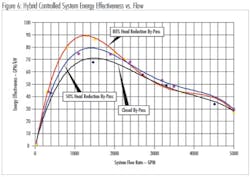Desalination: Worth Its Salt to keep the UK ahead of the game?
One of the UK's largest water utilities has opened the country's first major desalination facility in London. Tom Freyberg visits the site to look at the four-stage reverse osmosis technology and finds out how the new supply will help the city beat future water droughts.
The opening of the UK's first desalination plant may have come as a shock to some people. As a country notoriously known for its wet winters (and summers) and abundant non-tidal river and groundwater sources, many will question the need to spend £270 million on the Thames Gateway Water Treatment works. It is only until you look in more detail at the state of the country's water supply that you realise this facility is justifiable.
As with much of southern England, the Environment Agency categorises the Thames Water supply area as "seriously water stressed". Add to that a population set to increase by 700,000 by 2021 and the case for the facility starts becoming clear.
"Without finding a new source, we could not guarantee having enough water to supply all of London's needs during a drought," says Thames Water, the major utility behind the project, including the joint venture between Interserve Project Services and Acciona Agua.
Effectively the facility will be used as a "stand-by" source, connected to service reservoirs via 14km pipes and ready to supply 150 million litres of water a day, if required. The supply would most likely be used if the country was to suffer two "dry winters" in a row, according to principle project manager, Steve Baldwin. So, during prolonged periods of low rainfall, water from the plant will be mixed with existing supplies in the distribution network from other treatment works across London.
Facility Facts - Four Stage RODifferent to other desalination facilities, the Thames Water project includes a four-stage reverse osmosis process, which the utility describes as a "world first".
Water is taken from the River Thames in two three-hour periods each day, coinciding with the ebb tide, when water is flowing towards the sea. The aim is to help reduce the water's salt content, therefore reducing the required amount of energy to remove the salt.
Water is then held in buffer tanks, which have a capacity of 175 million litres, to save extracting water from the river during the day. It is then mixed during the flocculation stage, where a coagulant chemical is added. This causes suspended material, such as silt to flocculate, before the particles settle and drop to the bottom of the tank.
The first stage of the filtration process sees the salty water filtered using clay-based sand to remove much of the remaining suspended material. After the ultrafiltration stage, water is fed to the start of the four RO stages.
As a result of the increased number of RO stages, it is predicted that 85% of the water taken from the river Thames could be turned into drinking water. This, according to Thames Water, compares to 45% - 50% usually achieved by other facilities that treat seawater. Pressure is doubled at each RO stage, starting at 20 bar and increasing to 80 bar at the final stages. And it is not a small operation either. In total, 10,460 membranes are used throughout the entire filtration process.
In terms of facing problems such as membrane biofouling and replacement, Baldwin believes that because the facility won't be operating continuously, these issues shouldn't cause the plant too much of the headache.
"Membranes are improving all of the time and as the technology improves, we will be able to replace membranes as we go, allowing the plant to adapt," he says.
A common criticism of the desalination process is that it's energy intensive. In a bid to rid the project of this stigma, the company says that on-site generators can be run on biodiesel, recycled from used cooking oil. Also, waste energy from the fourth stage of the reverse osmosis system will be used to help run the third stage, with the aim of cutting net energy use.
However, certain industry experts remain unconvinced by the green credentials of the facility.
"To burn a liquid fuel to run a water plant that uses more energy than it might have done if it was a wastewater plant is a dubious justification," according to Dr Graeme Pearce, principle from Membrane Consultancy Associates (MCA).
Dr Pearce strongly believes that a wastewater treatment facility could have proved a more energy efficient alternative.
He tells Water & Wastewater International (WWi): "Wastewater reuse would have been better in energy terms. Beckton is more expensive than wastewater reuse, not massively more, but it is slightly more expensive. It was probable that Thames Water didn't go down the wastewater reuse route because when they were making these decisions the concept of using wastewater was not widely accepted. All these years later it's actually fairly standard. For example Los Angeles and Singapore receive a significant proportion of their water needs from wastewater reuse."
Dr Pearce says that although estuary desalination processes aren't as "energetically punitive" as true desalination schemes, they are challenging in other respects, such as having a variable salt concentration.
"From an energy point of view, they are cheaper to run than treating seawater. For example, the Beckton plant runs at 1.67 kWh per cubic meter, while treating seawater is about 3 kWh per cubic meter. That's a big difference. Wastewater reuse would be around 1 kWh per cubic meter. So the estuary source uses more energy than reuse, not by a massive margin, but it is higher."
Following the official opening in early June, it hasn't been an easy journey getting to this stage. Thames Water originally submitted plans to build a desalination plant back in June 2004. Despite the application being approved by the London Borough of Newham in March 2005, the previous Mayor of London, Ken Livingstone, directed the local authority to refuse the application.
After the objections had been tested in court, a case which Thames Water had won, it was later dropped by current Mayor Boris Johnson, shortly after he was elected.
Although being used as a back-up water supply, with Thames Water pre-empting future water shortages, population increase and potential droughts, the opening of the facility does raise the question of whether there is scope for additional desalination plants across the rest of the country. To date, Britain's desalination plants have been limited to small plants to top up agricultural or public supplies in Jersey and the Isles of Scilly.
So will Beckton act as a catalyst for more desalination facilities extracting water from UK estuaries and the coast in years to come?
"Really what we should do in this country, if we are short of resources, is to look first at wastewater reuse," says Dr Pearce. "From a Thames Water point of view, when they were thinking of the project back in 2002, it was too early a stage to think that wastewater reuse would be acceptable. Now, a number of years have past it has been accepted in various parts of the world and that's what we should do in the future."
He goes onto add: "Desalination is a choice of last resort, which doesn't mean to say there shouldn't be projects - there should be, but you need special circumstances to justify it. And in normal circumstances, like we have in Northern Europe, wastewater reuse should definitely be looked at first from an energy point of view."
Whether we will see more large scale desalination facilities, or even wastewater treatment facilities cropping up across the country, it remains to be seen. Energy and political issues aside, the utility and partners should be applauded for sticking with the project through its bumpy political path to the end.
The Thames Gateway region is expected to expand even more in future years and with the 2012 Olympic Games just around the corner, the demand for water in East London is only going to increase. Building the facility in the East End will help minimise distribution costs and locate the water where it will be needed.
With the added capacity, Thames Water has anticipated future water issues and is fully prepared for these eventualities, which can't be a bad thing.
More Water & WasteWater International Current Issue Articles
More Water & WasteWater International Archives Issue Articles



